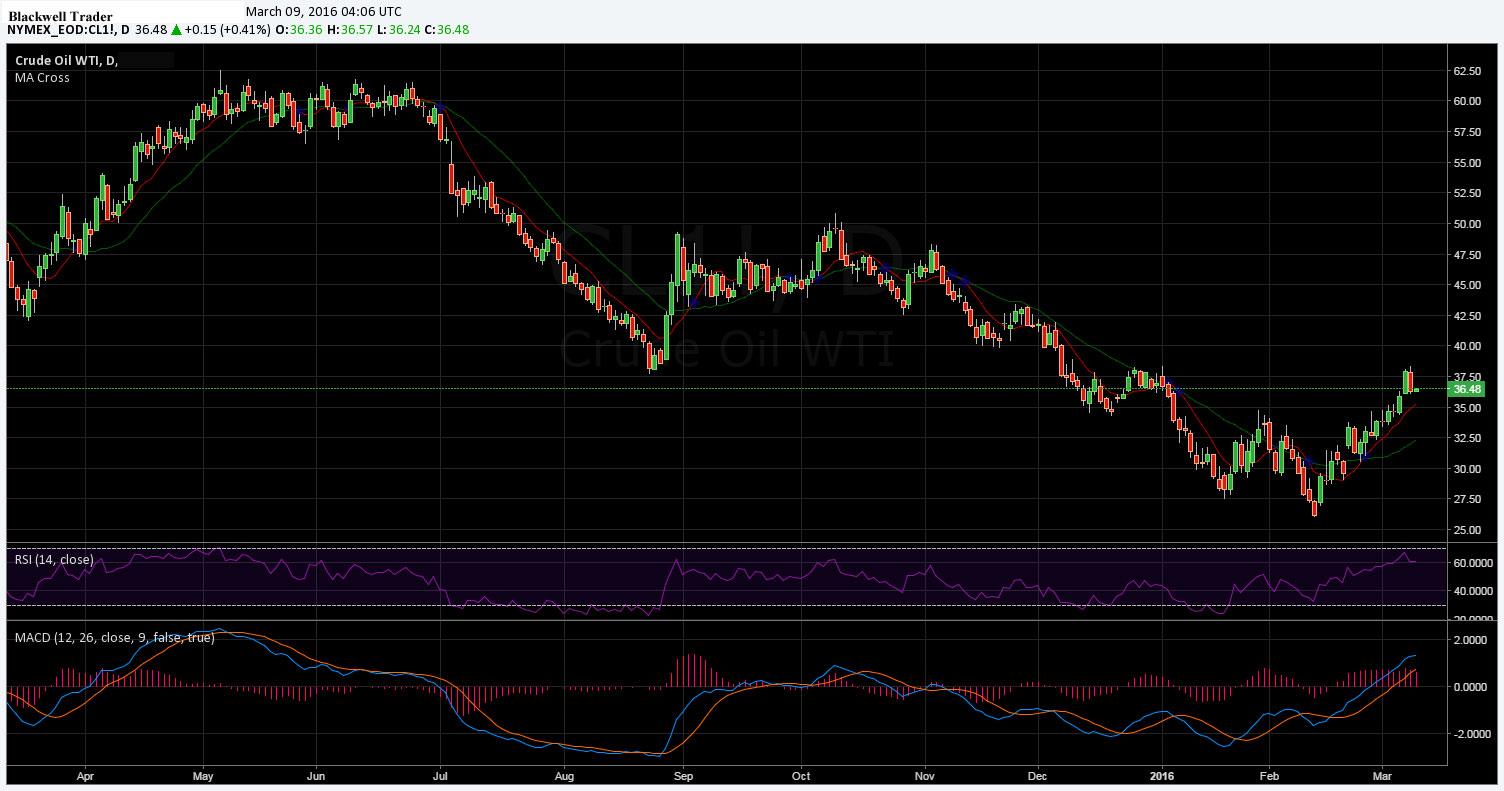Recently the markets have been awash with talk about crude oil seemingly having discovered a bottom to the recent decline. However, the supply fundamentals remain unchanged, and despite the talk of re-leveraging, there is only one way for crude prices to head and that’s down.
The past few weeks have seen the price of Crude Oil (WTI) surging amid talks of production capacity constraints and re-leveraging leading to inflation for commodity prices. Subsequently, prices have reacted strongly to the rhetoric and the past few sessions have seen prices rally to a high of $38.37 a barrel.
Much of the upward price pressure in crude oil markets has been driven by the initial phase in rebalancing, with a range of oil supply curtailments evident in both the US Shale Industry and amongst OPEC producers. However, the realignment process has largely lost out to the increasingly robust Eurozone manufacturing data, as well as a significant level of credit growth evident in China’s January figures. Subsequently, there is a view that much of the world is now starting to re-leverage which is likely to flow on to growth and ultimately demand for the black gold.
However, these short term market corrections do nothing to help the plight of the needed supply rebalancing. The Crude oil supply glut is still a significant problem within the industry and the only way to clear that imbalance is for lower prices and some significant hard ship. Although the current world economic dynamics may lend itself to taking a short term bullish view on crude, ultimately any rise is not sustainable.
Subsequently, we expect Crude Oil to continue its rebalancing efforts throughout the majority of 2016, regardless of any short term price moves. It is estimated that the market will not reach a new, stable equilibrium, until Q1, 2017. At that point it is likely that some significant upward pressure on prices will occur. Historically, it is clear that a sustainable rally can only be created through by a physical deficit in the crude markets. And until the rebalancing is complete, that is an unlikely prospect.
The state of the Chinese economy is also a concern for future oil prices in the broader economic sense. There is continuing deterioration within Chinese Manufacturing, subsequently supported by much of the easing measures undertaken by the PBOC. In addition, China also has some significant credit constraints which likely predisposes it to consider fiscal policy over any form of monetary stimulus. Subsequently, the uncertainty component of any ongoing shocks to the Chinese economy is a real risk to both crude and metals demand.
Ultimately, especially given the level of uncertainty in China, re-leveraging and reflation will not support crude oil prices in the long run. Genuine price rallies can only be sustained by a physical deficit and that means a continuing of the rebalancing process. Subsequently, expect the pain to remain until we genuinely see supply shifting thereby moving price towards new and stable equilibrium.
Risk Warning: Any form of trading or investment carries a high level of risk to your capital and you should only trade with money you can afford to lose. The information and strategies contained herein may not be suitable for all investors, so please ensure that you fully understand the risks involved and you are advised to seek independent advice from a registered financial advisor. The advice on this website is general in nature and does not take into account your objectives, financial situation or needs. You should consider whether the advice is suitable for you and your personal circumstances. The information in this article is not intended for residents of New Zealand and use by any person in any country or jurisdiction where such distribution or use would be contrary to local law or regulation. Knight Review is not a registered financial advisor and in no way intends to provide specific advice to you in any form whatsoever and provide no financial products or services for sale. As always, please take the time to consult with a registered financial advisor in your jurisdiction for a consideration of your specific circumstances.
Recommended Content
Editors’ Picks
EUR/USD clings to gains above 1.0750 after US data

EUR/USD manages to hold in positive territory above 1.0750 despite retreating from the fresh multi-week high it set above 1.0800 earlier in the day. The US Dollar struggles to find demand following the weaker-than-expected NFP data.
GBP/USD declines below 1.2550 following NFP-inspired upsurge

GBP/USD struggles to preserve its bullish momentum and trades below 1.2550 in the American session. Earlier in the day, the disappointing April jobs report from the US triggered a USD selloff and allowed the pair to reach multi-week highs above 1.2600.
Gold struggles to hold above $2,300 despite falling US yields

Gold stays on the back foot below $2,300 in the American session on Friday. The benchmark 10-year US Treasury bond yield stays in negative territory below 4.6% after weak US data but the improving risk mood doesn't allow XAU/USD to gain traction.
Bitcoin Weekly Forecast: Should you buy BTC here? Premium

Bitcoin (BTC) price shows signs of a potential reversal but lacks confirmation, which has divided the investor community into two – those who are buying the dips and those who are expecting a further correction.
Week ahead – BoE and RBA decisions headline a calm week

Bank of England meets on Thursday, unlikely to signal rate cuts. Reserve Bank of Australia could maintain a higher-for-longer stance. Elsewhere, Bank of Japan releases summary of opinions.
